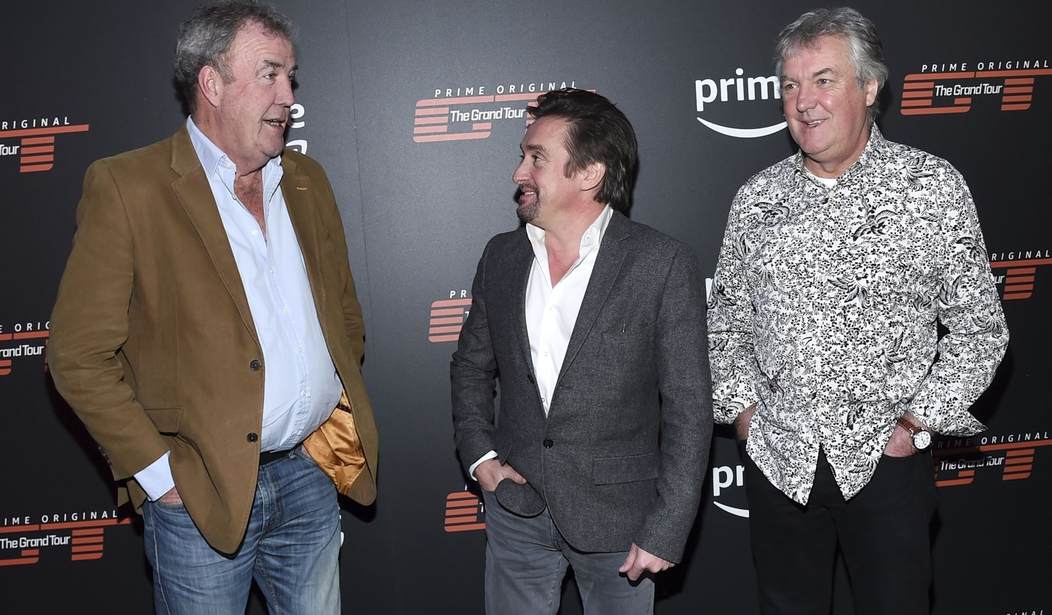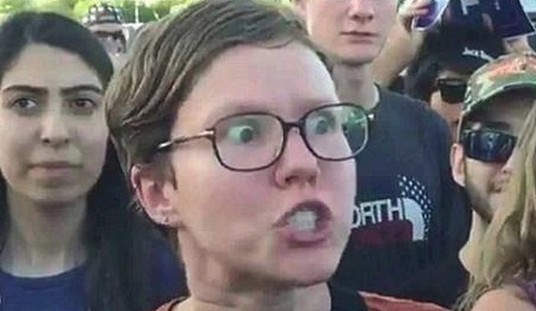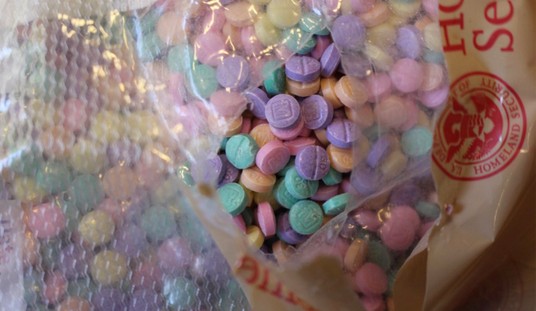Fans of The Grand Tour on Amazon Prime Video know the arc of the series quite well at this point. The BBC’s Top Gear, originally a staid program discussing boot space and fuel economy amongst British cars, debuted in 1977 and ran until 2001. In the 1990s, Tory motoring journalist Jeremy Clarkson, then sporting the most enormous Chia Head of permed hair that any man has ever worn, and spouting a million miles of car-related extremely un-PC hyperbole, emerged as the undisputed star of the program until he left for solo projects in 1999. Top Gear, suffering declining ratings in his absence, was canceled by the Beeb two years later.
While it was off-air, Clarkson and producer Andy Wilman created a new format, one that was an almost postmodern inversion of the original show. Out went road tests of boring cars that most viewers could afford, in came exotic and impossibly expensive European hypercars such as the Bugatti Veyron, the Pagani Zonda, and the Ferrari Enzo. Out went boring car journalists delivering earnest pieces to the camera proffering consumer advice standing with one shoe on their car’s bumper. In went three hosts yelling and bickering and sabotaging each other like they were overgrown high school kids as they attempted to build preposterous Rube Goldberg car-related projects such as transforming the three-wheeled Reliant Robin into a Space Shuttle, a Jaguar XJS convertible into a railroad locomotive, and a camper trailer into a blimp. Also present was an anonymous race car driver in a white racing jumpsuit who never spoke and never removed his helmet, and drove those Euro-hypercars around the show’s permanent racetrack like a demon.
Creating the car show equivalent of Monty Python’s Flying Circus, this version of Top Gear debuted in 2002, and became one of the most widely viewed shows on the planet until Clarkson, under enormous pressure in his personal and professional life, got drunk in 2014 and punched a producer. A furious BBC decided not to renew Clarkson’s contract, and the furious cast and crew decided to march off with him to the more lucrative world of streaming video.
As Clarkson himself recently wrote in the London Times, “I’d plan the TV show on Monday, write it on Tuesday, record it on Wednesday, and then be on stage on Thursday night in Johannesburg. Or Oslo. Or Budapest. I became frantic and possessed and mad and I was fired. And then along came Amazon, who noticed that every single person involved in the world’s biggest show was suddenly available. So we called the Hothouse Flowers, came up with the biggest, most flamboyant show opening we could afford — and we could afford a lot with Amazon behind us — and started all over again.”
Speaking of Amazon’s money, Wilman recently admitted that while they first considered moving from the BBC to a rival British TV channel, for the money to really produce the show on such a (pardon the pun) grand scale, they needed funding from the States, and looked at the various streaming platforms, including Netflix and Apple. And then “Amazon got in touch and we started talking and we liked the conversation — especially the one about money. It was like, ‘Make the show as legally close to Top Gear as possible’. No bones about it. ‘We want an up-and-ready show to go around the world [that] we ain’t going to get sued for, and you four are in.’”
The Grand Tour, the successor show to Top Gear that Clarkson and his cohosts, Richard Hammond and James May created, along with Wilman and former Top Gear script editor Richard Porter, was wildly uneven when compared to its beloved predecessor. But the chemistry of its three stars went far to make it, for the most part, usually quite watchable, particularly the segments shot outside of the studio of road tests and comedy car kitbashing, which retained the chemistry of their original BBC series.
When Amazon announced The Grand Tour, speculation was rife among the British tabloids that Jeff Bezos paid quite a hefty sum for it – $250 million, a figure that if true, is the same amount that he paid to acquire another long-running institution that’s really living off its former reputation, the Washington Post. According to Porter, the plan among the three presenters was to do three seasons and call it a day, but Amazon asked for a couple of more seasons. The trio and Wilman said yes, but only if they could ditch their studio audience, and focus on what they had dubbed their “specials” – beautifully filmed and intricately edited travelogues which placed the largely improvised car-related hijinks in exotic lands.
“So we put away the tent that had become our new home,” Clarkson recently wrote, “and went back to doing what we liked most of all: buying three terrible old cars and seeing if we could drive them over gruesome terrain to somewhere idiotic.”
The Grand Tour is grounded
And then 2020 happened. This made travel on the scale required to produce a show with The Grand Tour’s 4k visuals virtually impossible. The two episodes the show created at the height of lockdown in England featured their crew operating in what James May described as a “COVID bubble,” with loads of masks, and frequent COVID tests for all concerned, filming first in Scotland, and then not even leaving England, but focusing on the many eccentricities of French cars. Wilman referred to these two episodes as the equivalent of a rock group doing an “Unplugged” concert on MTV. For many viewers, they were the equivalent of the boys hosting a vintage Top Gear episode from 15 years ago. Not the most breathtaking locales, but plenty of mindless fun nonetheless.
Beyond COVID, there are now myriad foreign conflicts making much of the world unsafe to travel. The Grand Tour’s “Scandi Flick” special from 2022 was originally conceived as being filmed in Russia. And then Putin rolled the tanks into Ukraine. Or as Clarkson explained in at the beginning of last year’s “Eurocrash” episode, “If you think about all the places we’ve been to in recent years, places that were stable when we were there, that aren’t anymore. Mozambique. Syria. Iraq. Burma. Ukraine. Russia. We couldn’t go back to any of them. Or, for different reasons, Argentina.”
Clarkson and crew wound up on Amazon because of his fight with first a Top Gear producer, and then with BBC management. In late 2022, he seemed determined to repeat the process, by writing a column for the Sun, badly deploying a Game of Thrones metaphor, and calling for Meghan Markle to be paraded “naked through the streets of every town in Britain while the crowds chant, ‘Shame!’ and throw lumps of excrement at her.” Apparently, much groveling with Amazon was done by the veteran TV host and journalist to keep his popular Clarkson’s Farm TV series. Whatever happened behind the scenes, no doubt, this also played some factor in the decision to wrap up The Grand Tour, beyond Clarkson’s admission that “after 36 years of talking about cars on television, I’m packing it in, because I’m too old and fat to get into the cars that I like and not interested in driving those I don’t.” In addition, as Clarkson admits in "One of the Road" while driving his Lancia Monte Carlo and enjoying its engine revving at full chat, “Love that sound. And all you lot growing up today with your electric cars, you're never gonna hear it. There are lots of reasons why we're jacking this show in, but for me, one of the main ones is I'm simply not interested in electric cars. They are just white goods. They're washing machines, they're microwave ovens. And you can't review those, you can't enjoy them. They are just shit.”
Riding off into the sunset
As the title implies, "One for the Road" is the last show. As Clarkson told the Daily Mirror, Andy Wilman’s brief for the last episode was “Leave the dynamite at home.” And with less things blowing up, it’s a wistful look back at the Top Gear specials of old, with the boys in three vintage cars driving through first the incredible scenery of Zimbabwe, which Top Gear couldn’t film in because the BBC is banned there, and then where the Top Gear specials all began, Botswana. Along the way, there are callbacks to other elements of the specials, such as the comedy backup car, boating, the A-Team theme song when it’s time modify the cars, etc. And a moving look back at the locations and cars from Botswana, until the final credits roll.
As Benji Wilson writes in the London Telegraph, giving the last episode four out of five stars, “slowly, tearfully, TV’s three amigos park up for good:”
Clarkson, of course, has Amazon’s biggest hit Clarkson’s Farm to return to. He plainly couldn’t give two hoots, and a less prickly Jezza is much better company than usual. Every now and then, as they drive off leaving a flailing Hammond behind to contend with his decrepit Mark One Capri, or as they make camp and talk about how great beer is, there is a sense of going through the motions. But then it’s actually felt like that for nearly a decade now, ever since they ditched actual motoring journalism in favour of doing “The Three Stooges on four wheels ad infinitum”.
If you don’t like that act, you most likely wouldn’t be tuning into The Grand Tour for its last lap anyway. Still, there is a likeable, even moving quality to this send-off. As Clarkson notes in an early diatribe, cars aren’t as interesting as they used to be: electric cars are essentially just new white goods. Views and reviews take place largely online. The trio pioneered the idea of the “Is it just me?” contrarian, but that mantle has now been taken over by keyboard warriors and social media mavens.
In short, things have moved on. What makes One for the Road so enjoyable is that Clarkson and co are resolutely unbothered. They take themselves off to Zimbabwe for a nice drive. They pick cars they like, because, well, they like them. They travel with some of the best camera crews in the business, as they have always done, and so the backdrop to their witterings is exquisite. No dials are moved, no envelopes maxed. But slowly, quietly and with surprisingly little shouting, a TV era is over.
So with the last Grand Tour complete, what can we say about the show? Looking back at 15 years or so of streaming television, what South Park called “Memberberries” clearly dominates all of the major platforms. Beyond the endless assortment of old movies and TV series that is the core library of each streaming platform, Disney+ has its myriad of (for the most part) mediocre Star Wars-themed series and Beatles-related titles. Paramount+ has its myriad of (for the most part) mediocre Star Trek-themed series. In 2019, Netflix released The Irishman, which was a glacially slow callback by Martin Scorsese to his much better earlier gangster movies, and in 2018, acquired the rights to Monty Python’s Flying Circus in all its various incarnations. Earlier this year, Apple TV released Masters of the Air, which is the sequel to the earlier WWII-themed series, Band of Brothers and The Pacific. And of course, all major platforms have their endless collections of old movies and TV series. While streaming is still the cutting-edge format to watch television, nostalgia dominates it at every turn.
But while The Grand Tour was clearly designed to be as, Wilman said above, “as legally close to Top Gear as possible,” it also represented Top Gear as the men who rebooted the series in 2002 intended it be, not a platform to grind the stars down for their unwoke views, which is what so many of the Star Wars and Star Trek spinoffs were created to do. Given its location on a streaming platform rather than a terrestrial TV channel, the show could never capture the enormous viewership of the original series, and the benefits of that enormous viewership, such as the Top Gear Live show that played European sports stadiums. (Clarkson once referred to The Grand Tour as “Top Gear in witness protection.”)
Also, the car itself is now under constant attack by the enviro-mental left, something Clarkson notes in the last episode. The last Grand Tour is now available for streaming, and at least for now, as a result of a horrific accident by one of its presenters, the BBC has cancelled or temporarily rested its own successor version of Top Gear. With the exception of Richard Hammond’s Workshop, his car restoration-themed series on the British Discovery Channel, and vague talk about rebooting The Grand Tour with younger hosts, there are currently no car-themed TV series being made for British terrestrial TV, and in America, even Jay Leno’s Garage is now on YouTube, not CNBC. The action has moved to YouTube, where the much smaller budgets allow for nowhere near the eye-popping cinematography of The Grand Tour, or its enormous production values.
In the meantime though, in addition to countless hours of their previous shows, as Car and Driver concludes, we have “one last ride for glory across beautiful scenery in the wild places of the world, in 50-year-old cars that weren't even particularly reliable when new. One more time to watch Clarkson and Hammond get on May's nerves. One final hangout with three friends who clearly knew they were very lucky to be creating something wonderful, and lasting.”










Join the conversation as a VIP Member